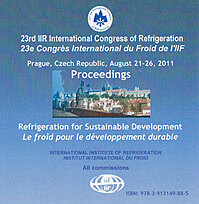
IIR document
Heat and mass transfer in the defrost process: a new modelling paradigm.
Number: pap. ID: 158
Author(s) : MOHS W. F., KULACKI F. A.
Summary
An important problem in the refrigeration industry is the formation and removal of frost layers on surfaces of sub-freezing air coolers. Frost directly diminishes the performance and efficiency of the entire refrigeration system by presenting resistance to the air flow and heat transfer in the air cooler. To return the system to pre-frosted performance, the frost layer is removed through a defrost cycle. Current methods used for defrosting, namely applying heat directly to the frosted surface, are inherently inefficient. A majority of the applied heat is lost to the surrounding environment through convective and conductive heat transfer. While previous studies have investigated the defrost process, the majority of them have been experimental evaluations of defrost on the refrigeration system and air cooler. Only a few studies have attempted to describe analytically the fundamental heat and mass transfer processes of the frost melting process. The authors propose a new defrost model to describe the frost melting process at the surface level through all phases of the defrost cycle.
Available documents
Format PDF
Pages: 8 p.
Available
Public price
20 €
Member price*
Free
* Best rate depending on membership category (see the detailed benefits of individual and corporate memberships).
Details
- Original title: Heat and mass transfer in the defrost process: a new modelling paradigm.
- Record ID : 30001581
- Languages: English
- Source: Proceedings of the 23rd IIR International Congress of Refrigeration: Prague, Czech Republic, August 21-26, 2011. Overarching theme: Refrigeration for Sustainable Development.
- Publication date: 2011/08/21
Links
See other articles from the proceedings (569)
See the conference proceedings
Indexing
-
Heat transfer with frosting phenomena under nat...
- Author(s) : YOSHIOKA R., INOUE S., OHKUBO H.
- Date : 2010/06/07
- Languages : English
- Source: ACRA2010. Asian conference on refrigeration and air conditioning: Tokyo, Japan, June 7-9, 2010.
- Formats : PDF
View record
-
Study on mass transfer with frosting phenomenon...
- Author(s) : INOUE S., OHKUBO H.
- Date : 2010/06/07
- Languages : English
- Source: ACRA2010. Asian conference on refrigeration and air conditioning: Tokyo, Japan, June 7-9, 2010.
- Formats : PDF
View record
-
A model of hot-gas defrosting of evaporators. 1...
- Author(s) : KRAKOW K. I., YAN L., LIN S.
- Date : 1992
- Languages : English
View record
-
Frost growth and densification on flat surfaces.
- Author(s) : CHEIKH A. el, JACOBI A.
- Date : 2012/07/16
- Languages : English
- Source: 2012 Purdue Conferences. 14th International Refrigeration and Air-Conditioning Conference at Purdue.
- Formats : PDF
View record
-
Unsteady heat and mass transfer during frost fo...
- Author(s) : LENIC K., TRP A., FRANKOVIC B.
- Date : 2006/10/25
- Languages : English
- Source: Energija i okolis 2006. Medunarodni kongres: XX. znanstveni skup o energiji i zastiti ikolisa./ Energy and the environment 2006. International congress: 20th Scientific Conference on Energy and the Environment.
- Formats : PDF
View record
